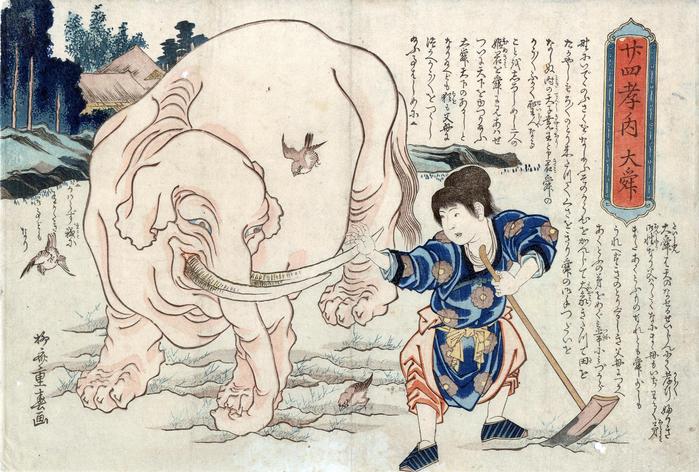Ryūsai Shigeharu (柳斎重春) (artist 1802 – 1852)
Taishun (大舜) cultivating the land with the help of an elephant - from the series 24 Paragons of Filial Piety (廿四孝ノ内)
1829
15 in x 10.5 in (Overall dimensions) Japanese woodblock print
Signed: Ryūsai Shigeharu ga
柳斉重春画
Achenbach Foundation for Graphic Arts
National Library of Australia - another print from this series Below is R. Keller Kimbrough's translation of an early edition of the Nijūshikō. It does not specifically apply to this Shigeharu print except in the most general terms.
[1] Great Shun 大舜 (Da Shun)
Elephants in a row, tilling in the spring;“Great Shun was an exceedingly filial person. His father, whose name was Kosō 瞽叟—“Blind Old Man”—was remarkably stubborn, and his mother had a twisted heart. His younger brothers were extremely arrogant, and they were worthless, too. Nevertheless, Great Shun was fervent in his filial piety. One time when he was farming at a place called Mount Reki, Heaven was moved by his filial devotion.5 Great elephants came and tilled his fields, and birds flew to him and pulled the weeds, aiding him in his cultivation. At that time the ruler of the realm was named Emperor Gyō 堯王. He had two daughters, the elder of whom was called Gakō 娥皇, and the younger, Joei 女英. Having received word of Shun’s filial piety, Emperor Gyō immediately gave him his daughters to be his empresses, and in the end he left him the realm. This happened entirely as a result of Great Shun’s profound sense of filial piety.”
a flock of birds weeds the fields.
Succeeding Gyō, he rises to the jeweled throne;
his filial piety moves the emperor’s heart.
****
Laura Allen wrote on page 153 in The Printer's Eye: Ukiyo-e from the Grabhorn Collection in reference to an Okamura Masanobu of this same theme: "The series title Twenty-four Paragons of Filial Piety refers to a work said to have been composed by the Yuan dynasty (1279-1368) Chinese scholar Guo Jujing. The subject of this print is a virtuous young man known as Dashun (or simply Shun), who never deviated from proper respect toward his family despite harsh treatment from his father, his cruel stepmother, and her jealous son. When scolded or beaten, he simply escaped outside, cultivating the family fields alone. Noting his filial devotion, creatures emerged from the nearby mountains to help: in spring elephants came to plow the furrows, and in summer birds flocked to pull weeds. When the emperor heard this tale, he stepped in and guided the young man, until eventually Shun assumed the throne himself and became a virtuous ruler."
****
This print "...was probably issued during Shigeharu's years of highest productivity across 1829 and 1830. The paragons of filial piety are Chinese legendary or historical figures noted for their proven devotion to their parents. The concept of such obedience to one's parents guaranteed the continuation of the family system as well as providing the basis for the larger Confucian social system. These subjects are frequently illustrated by Japanese print artists, but this may be the only set by an Ōsaka artist. While the printing is quite delicate and clear, it is also relatively simple. Away from the conventions imposed by the theater print and within the realm of Chinese tales, the artist used a style reminiscent of Hokusai or Kuniyoshi, and many of the designs are quite ingenious."
Quoted from: Osaka Prints by Dean Schwaab, p. 246.
Schwaab continues on page 247 specifically about the print in the Lyon Collection: "As a boy Taishun suffered the vagaries of a difficult blind father, as well as a pitiless stepmother and half-brother. When he was still a young boy, his parents demanded that he cultivate a very large area of land. Uncompromising, he did so, aided in his task by an elephant of the Emperor Yao - the semi-mythical founder of China - who, hearing of his remarkable filial piety, gave him his daughter in marriage and appointed him successor to the throne."
****
There is another copy of this print in the Osaka Art Museum.
****
The National Library of Australia notes: "The print sets depict scenes from the famous stories of China, the Twenty-four Filial Exemplars, also translated as Filial Piety. This is a classic text of Confucian filial piety written by Guō Jūjìng, a scholar of the Yuan dynasty (1260–1368). The text was extremely influential in the medieval Far East and was used to teach Confucian moral values."
****
Illustrated
1) in a small black and white reproduction in The Male Journey in Japanese Prints by Roger Keyes, University of California Press, 1989, p. 12.
2) in color in Osaka Prints by Dean J. Schwaab, Rizzoli, 1989, page 247, no. 280.
mitate-e (見立て絵) (genre)
Nijūshikō (二十四孝: The twenty-four filial exemplars) (genre)
